
Psst. I know what everyone is really hoping you’ll cook this weekend, and I’m sorry, it is not that kale salad. Okay, maybe not if these people are gluten-free, or opposed to butter, burnt sugar and stretchy yeasted breakfast treats. You probably shouldn’t make this for anyone on a juice cleanse or auditioning a paleo lifestyle. And now that I’ve ruled most of the people on this earth out, maybe I should stop talking about “everyone” when what I really mean is me.
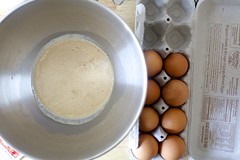
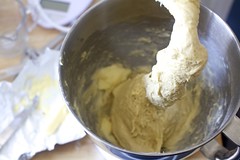

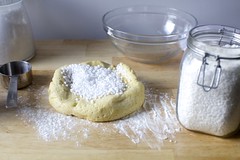
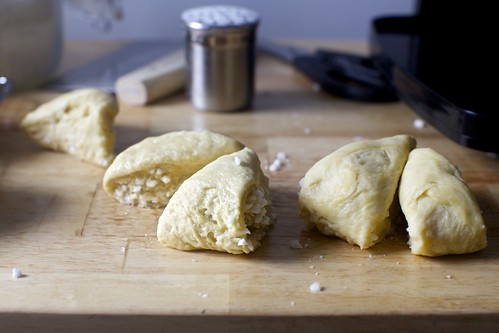
I have never been to Belgium, but the further I get along in this whole incubation process, the more I predictably long for the kinds of trips that will seem impossible to pull off for some time. I’d like to have an ale, probably two, in some ancient cobblestoned courtyard, eating pommes frites (RIP, sigh) from paper cones and then stumble around Bruges, gazing at canals and medieval architecture, eating my way through one stand after another until only the first paragraph’s kale salad will save me.
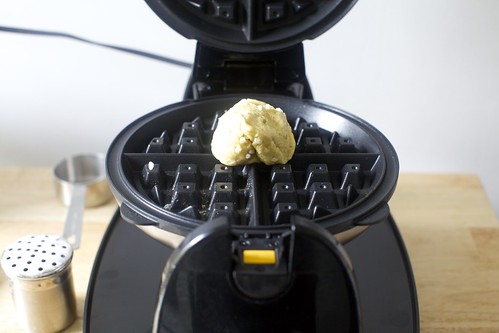


My unsatisfied wanderlust has not stopped me from forming an obsession with the dense, chewy and caramelized brioche waffles known as gaufre de liège, which have about as much in common the “Belgian” waffles we grew up with at IHOP, as, well, IHOP has to do with internationality.* Liège waffles are tiny, rich and intense; stretchy, layered and faintly crunchy within from embedded pearls of sugar and firm on the outside from that same sugar melted and trickling about the waffle iron’s grids to form a caramelized shell. It’s not the kind of thing you can have a single bite of and forget; do not plan to have an easy time going back to the pancake-batter-in-waffle-molds that were once a harbinger of a great weekend morning.
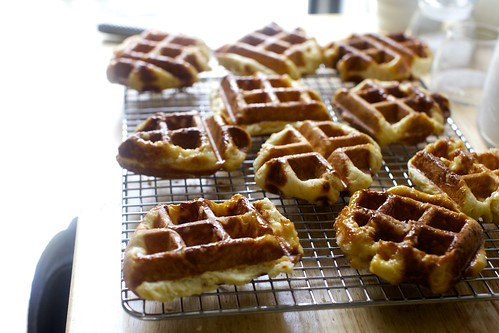
At their core, they’re an extra-buttery brioche dough given a luxurious rise before being studded with coarse sugar and scooped in doughy mounts onto a waffle iron. However, most of the recipes I could get my hands on were terrifyingly complex. I have little doubt that they’d make something transcendent, but if the process is so involved — say, the 90 minutes at room temperature then more mixing then another 4 hours, followed by 30 minutes, followed by an overnight in the fridge and another 90 on a counter of a well-respected and excellent recipe — that it results in no homemade liège waffles in your life, it has still on some level failed us. I did my best to streamline the number of processes, odd measurements and the extreme sweetness in many of the recipes to make a caramelized brioche waffle that is unforgettable… and also doable, and thus repeatable. Don’t even try to only make these once.
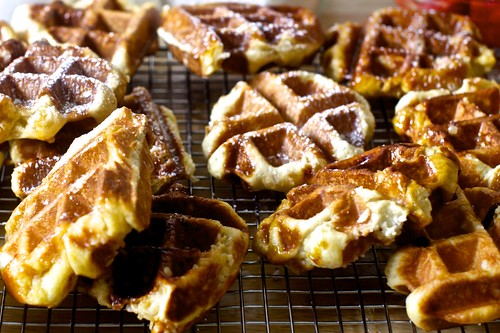
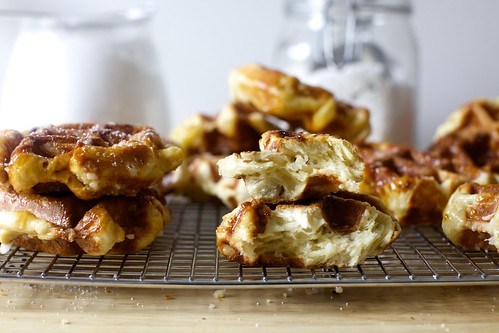
* Although, 1) IHOP, I still kinda love you and 2) it’s not totally your fault. The Belgian waffles we know of in America are an oronym (word of the day alert!) of the “Bel-Gem Waffle,” the Brussels waffle vendor that brought them to American via the 1964 New York World’s Fair, and started something of a national waffles craze. “Bel-Gem” mutated into “Belgium” then “Belgian” and the name stuck.
I’m obsessed with my new waffle maker: Over the years on this site, I’ve lamented that I didn’t understand why waffle makers didn’t come with removable plates. “Just wipe it out with a sponge!” everyone told me but omg, my last waffle maker had 360 channels and 240 keyboard-like bumps (you’d better believe I counted) and after December’s sticky gingerbread waffles, I swore off waffles until I either stopped caring about whether I was cooking on truly clean appliances or found a model that valued time not spent cleaning as much as I do. I ultimately found two: the first (a tip from several readers, thank you) is Cuisinart’s Griddler, for which you can buy additional waffle plates (rather steeply discounted on Amazon right now). Everyone seems quite happy with the product, and the system would have been perfect… had I desire or need for a Griddler. So I bought the second one instead, a simple model from Hamilton Beach that has proven so easy to use and clean, I fear our waffle intake has increased tenfold. Thus, consider this a product recommendation and a warning. 🙂 As always, not sponsored.
One year ago: Fresh Spinach Pasta
Two years ago: Essential Raised Waffles
Three years ago: Bacon Egg and Leek Risotto
Four years ago: Creme Brulee French Toasts
Five years ago: Homemade Pop Tarts, Cabbage and Lime Salad with Roasted Peanuts, Leek Bread Pudding and Oatmeal Pancakes
Six years ago: Ranch Rugelach and Cinnamon Raisin Bagels
Seven years ago: Green Bean and Cherry Tomato Salad
Eight years ago: Pineapple Upside-Down Cake
And for the other side of the world:
Six Months Ago: Smoked Whitefish Dip with Horseradish
1.5 Years Ago: Spinach and Egg PIzzette
2.5 Years Ago: Homesick Texan Carnitas
3.5 Years Ago: Granola-Crusted Nuts
Liège Waffles
Heavily tweaked from the excellent Gaufre de Liège Recette Blog and the copious notes of Not Martha
I’m pretty sure these waffles can be described with a Zagat-style collection of every one of my dessert trigger words and phrases: caramelized, chewy, burnt sugar caramel, stretchy, buttery, reminiscent of a croissant, doughnut and brioche at once. But don’t let that convince you; try them for yourself. I did my best to streamline the ingredients and processes in a way that would make these doable but also uncompromised in flavor and texture, making them two ways: one with a countertop rise followed by a long nap in the fridge and one in the reverse, in hopes to accommodate all of our schedules. While the process could be sped up further by skipping the cold overnight rise, you will be absolutely bowled over by the depth of flavor (and aroma, swoon, of the steam releasing from your waffle maker alone) that comes from giving the yeast more time to develop. Finally, I did not try this with instant yeast, but have found in other recipes that you can replace one with the other, but that instant yeast takes a little longer. However, you do not need to warm the liquid.
Makes 16 thick waffles, just about 4 inches across each.
1/2 cup (120 ml) milk, whole is ideal
1/4 cup (60 ml) water
2 tablespoons raw sugar, brown sugar or honey
1 packet (7 grams or 2 1/2 teaspoons) active dry yeast
2 large eggs, ideally at room temperature
2 teaspoons vanilla extract
3 2/3 cups (460 grams) all-purpose flour, divided
1 teaspoon coarse or kosher salt
14 tablespoons (200 grams or 7 ounces) unsalted butter, softened
1 1/3 cups pearl sugar (see Note at end for sources)
Make dough: Warm milk and water together to lukewarm, or between 110 and 116 degrees F, and place in the bottom of a large mixer bowl. Add sugar and yeast and stir to combine. Set aside for 5 minutes; the yeast should look foamy.
Whisk in eggs and vanilla, then stir in all but 1 cup flour (you can eyeball this) using a spoon or the dough hook of a stand mixer. Add the salt and mix to combine. Using the dough hook of a stand mixer, add the butter, a spoonful at a time, thoroughly kneading in each addition and scraping down the bowl as needed before adding the next until all of the butter has been mixed in. This is always my least favorite step in brioche because it feels like it takes forever to get that butter worked in, but it pays off in a stretchy, layered dough, promise. Add remaining flour and knead with dough hook on low speed for 5 minutes, or until glossy.
Set dough to rise twice: You can let the dough rise two ways, first at room temperature and then in the fridge, or vice-versa:
For room temperature first, cover bowl with plastic wrap and leave at room temperature for 2 hours; dough should double. Stir with a spoon or spatula to deflate into a mound, re-cover with plastic wrap and let chill in the fridge overnight, or up to 24 hours.
For fridge first, cover bowl with plastic warp and leave in the fridge overnight, or up to 24 hours. The dough will not look fully doubled when you take it out. The day you’d like the make the waffles, bring the dough back to room temperature for 60 minutes, stir to deflate, and let rise again for another 1 1/2 to 2 hours.
To cook the waffles: For both methods, on the day you’re ready to make the waffles, knead in the pearl sugar. It’s going to seem like way too much for the dough, but it will taste perfect once cooked. Divide dough into 16 mounds. If it’s rather warm and greasy, you can return these balls of dough to the fridge while you cook them off, one or a few at a time.
Heat your waffle iron — I use a deeper Belgian-style one here, which is ideal, but I’d expect these to work with all types — over medium heat. No need to oil or butter if it’s nonstick in good condition. Place first ball of waffle dough on grid and cook according to waffle maker’s instructions. Cook until deeply golden all over, which will take approximately 5 minutes, then carefully transfer with tongs or a fork to a cooling rack. Remember, they’re loaded with molten sugar; they’re very hot. Repeat with remaining balls of dough, adjusting temperature of waffle iron as needed to get the color you want. You’ll likely find that the waffles look more caramelized and glossy as you go on, as bits of melted sugar stay behind and gloss the next waffles; this is the best part.
Keep waffles warm in a 200 degree oven if you plan to eat them right away. As the waffles cool, they will harden and you will likely think “what a ruse! What a terrible recipe!” but the hardness comes from that melted sugar firming up, and will soften again when you rewarm them. These waffles should always be eaten warm.
To serve: You can serve these any number of ways: with ice cream or whipped cream, Nutella and/or sliced fruit but I adore them plain and always warm. There’s so much flavor, they don’t even need a dusting of powdered sugar to feel finished.
Keep leftover waffles, should such a thing exist, in the freezer. If you’re making the full batch with the express intent of freezing them, you might want to cook them to half-a-shade lighter, so that when they’re reheated in a 200 degree oven, they won’t get too dark.
Cleaning up: As you make more and more of these waffles, the melted sugar might pile deliciously up on your waffle iron. As I mentioned above, I’ve fallen in love with a waffle maker with removable plates and sure didn’t mind the ease with which I cleaned this up. But don’t fret if you’re stuck with the well, stuck, kind, even if it’s coated with hardened caramel because warm water melts sugar, 100% of the time. Thus, a rubbing even a non-abrasive soaked in warm water back and forth over any sugar-hardened bits will dissolve them.
Finding pearl sugar: [Sometimes sold as nib or hail sugar, Hagelzucker
in Germany, pärlsocker or perlesukker in Scandinavia, raesokeri or helmisokeri
in Finland, sucre en grains in France] Honestly, I would have shared a recipe for these years ago had so much of the waffle’s loveliness not hinged on an ingredient that — should you not be still working through the kilo bag you bought at G. Detou in Paris in 2008, heh — requires you to seek it out. But with a little looking, you’ll find it many places: IKEA sold it for years; it’s not on their site but worth finding out if still stocked. Amazon has ample options. King Arthur, Sur La Table. New Yorkers, couldn’t find it on their site, but I’d fully expect NY Cake to carry it, and I understand that Kalustyan’s has in the past. LA, I think Sufars has it.
Make pearl sugar: David Lebovitz — a man with such an impassioned following that the day he linked to a recent recipe on this site, two different parents came up to me at kindergarten drop-off to ask if I really knew him — gave me a great tip this week: crush sugar cubes into coarse bits to create makeshift pearl sugar. And here’s an even more DIY approach. I haven’t tested these out (see above: circa 2008 impulse buy) but I have a feeling they’ll get you close to what we’re going for here.
Source: http://feedproxy.google.com/~r/smittenkitchen/~3/JVD2KyMFfMg/